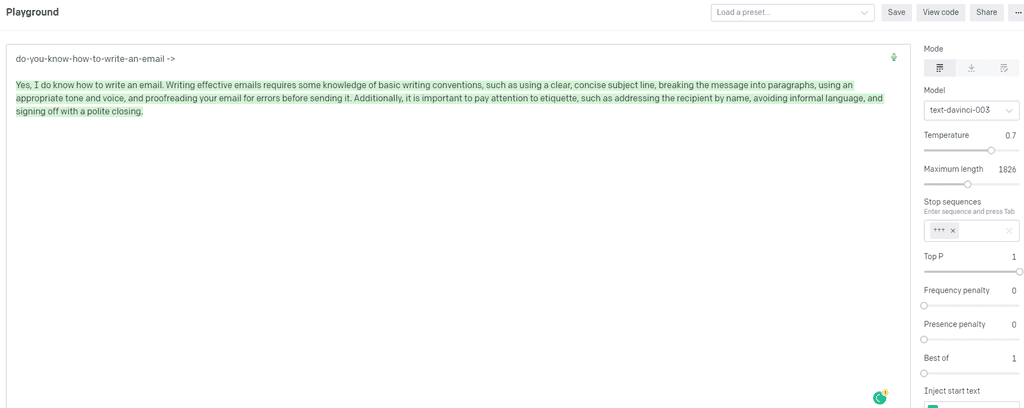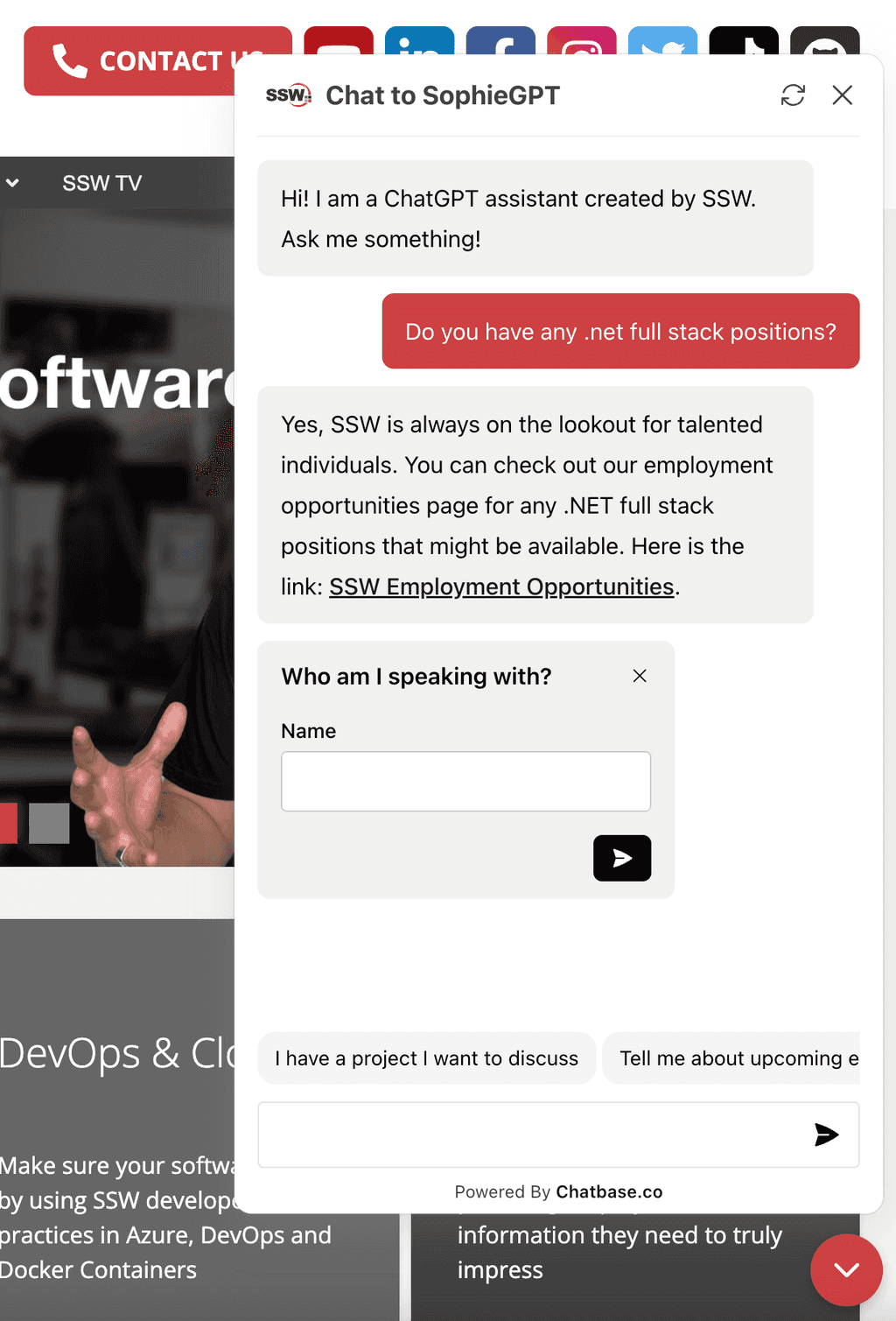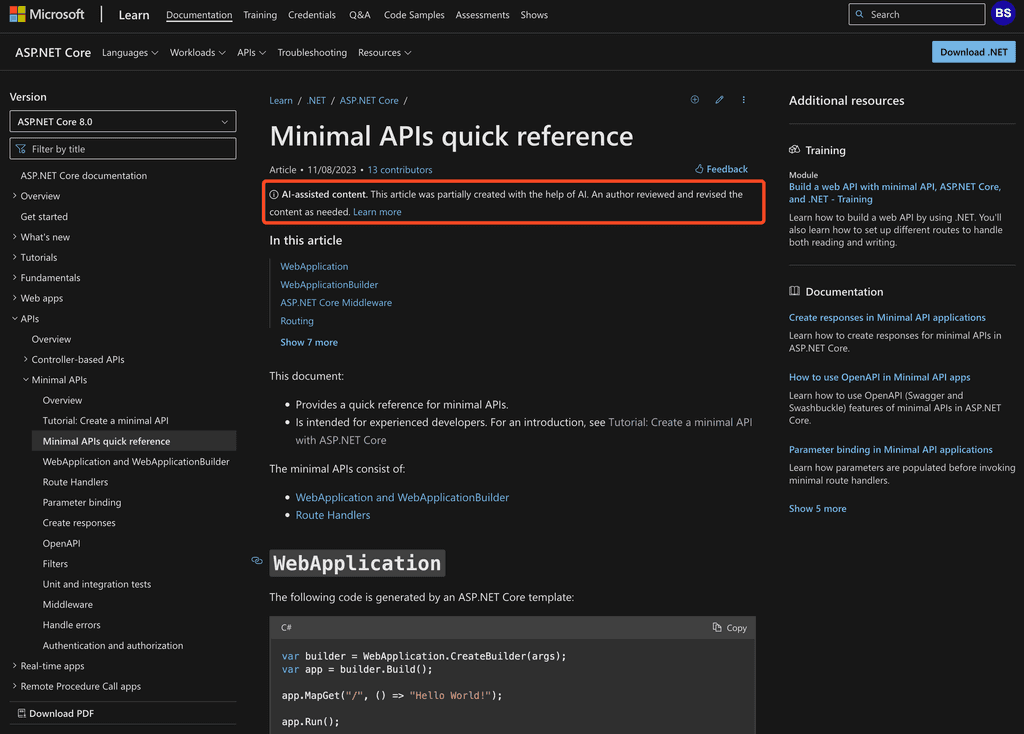Rules to Better GPT - 17 Rules
Want to revolutionize your business with GPT and ChatGPT integration? Check SSW's GPT and ChatGPT consulting page.
ChatGPT is a user friendly way to interact with OpenAI's GPT models. Essentially, it takes a model of GPT that is fine tuned for dialogue and turns it into a chat bot that responds in a human-like manner.

Figure: ChatGPT is built by OpenAI, which has Microsoft as an investor! ChatGPT is a conversational language model from OpenAI, accessible both on web and mobile that makes it easy to have conversations with OpenAI's GPT models, and adds lots of cool features on top, allowing your conversations to be much more natural.
It also saves your message history so that you can go back and look at your conversations later!

Figure: ChatGPT provides human like responses! Why is ChatGPT cool?
As an AI language model, I don't have personal opinions or emotions. However, I can tell you why ChatGPT is useful and popular among users:
Natural language understanding: ChatGPT has been trained on a large dataset of diverse text and is able to understand the context and meaning of words and phrases, allowing for more human-like conversations.
Versatility: ChatGPT can perform a variety of tasks, including answering questions, generating text, translating languages, and more.
Speed and efficiency: ChatGPT can generate responses quickly, making it a useful tool for conversational interfaces, customer service, and other applications that require quick responses.
Accuracy: With its vast knowledge base and language processing capabilities, ChatGPT is able to provide accurate answers to a wide range of questions and can generate high-quality text that is often difficult for humans to distinguish from text written by a person.
Overall, the ability of ChatGPT to understand and generate human-like text has made it a popular tool for businesses and individuals looking to enhance their conversational interfaces and improve their productivity.
Figure: ChatGPT's response when asked "Why is ChatGPT cool?"
ChatGPT is an incredibly powerful tool. GPT-4 is a noticeable improvement over GPT-3.5, and we can only expect the subsequent models to be even more impressive. For now, it does have its skills and weaknesses.
Here are the most important things for which we know it to be useful (and not):
✅ Use it for
1. Writing
It can draft emails, reports, proposals, writing projects, and templates, as well as proofread and edit documents.
"Please help me draft an email to my team about an upcoming project deadline." "Can you proofread and edit this short report on the effects of climate change?"
2. Summarization
It can create concise summaries of meetings or lengthy documents/text.
"Summarize the key points from this article about the latest advances in renewable energy." "Provide a summary of the main ideas discussed in this meeting transcript."
3. Coding
It can assist with coding tasks by offering suggestions, debugging code, generating code snippets, and providing explanations for programming concepts.
"I have this Python code with a syntax error, can you help me debug and fix the issue?"
"How do I create a simple function to calculate the factorial of a number in JavaScript?"4. Creativity
It can generate new ideas, offer creative suggestions, and provide guidance on resolving conflicts or addressing challenging situations.
"Suggest some innovative ideas for a sustainable urban transportation system." "Give me 20 ideas for what I should do my next software blog about."
5. Content
It can generate engaging content for various platforms, including social media, presentations, etc.
"Create a catchy social media post to promote our upcoming product launch." "Design an engaging PowerPoint slide to present our company's quarterly performance."
6. Critiquing
It can provide constructive feedback on various forms of work (in text format only), such as writing, presentations, and code.
"Please review this essay on the history of artificial intelligence and provide feedback on its structure, clarity, and overall quality." "Please assess this business proposal for a new startup, focusing on its feasibility, potential risks, and growth opportunities."
7. Learning
It can provide resources, explanations, and tutorials on almost any topic.
"Explain the basics of quantum computing and suggest some resources for further learning." "How can I learn to play the guitar? Please provide a tutorial or some beginner tips."
8. Research
It can gather information on various topics, analyze data, conduct SWOT and competitive analyses, and weigh pros and cons of different options.
"Conduct a SWOT analysis for Tesla and identify its main competitors in the electric vehicle market." "What are the pros and cons of using solar power as a renewable energy source?"
9. Translation
It can help in translating text between languages, providing quick and reasonably accurate translations for both personal and professional use.
"Translate the following English text to French: 'Hello, my name is John, and I will be your tour guide today.'" "Translate this German sentence into English: 'Das Wetter ist heute sehr schön.'"
And there are also areas where it performs poorly.
❌ Dont use it for
1. Non-textual information
It is not designed to process or generate images, audio, or other non-textual information.
2. Mathematics
While it can handle basic arithmetic and some mathematical concepts, it is not designed for advanced or complex mathematical problem-solving.
3. Emotion and empathy
It can mimic emotions, but it doesn't truly experience or understand them, which can lead to inappropriate or tone-deaf responses.
4. Context understanding
It may struggle with understanding context and maintaining continuity when a conversation gets long. 🤖
GPT is a large language model developed by OpenAI with major financial backing from Microsoft, and is currently leading the market in terms of technology and capability.
AI technologies have been being developed at companies like Amazon, Google and Microsoft for some time. The first large language model, GPT-1, was released by OpenAI in 2018.
It wasn't until the release of ChatGPT, which is powered by GPT, that the technology became widely known.Isn't it called ChatGPT?
Whilst sharing similar names ChatGPT and GPT are different.
GPT stands for Generative Pretrained Transformer and refers to the large language model that underlies the ChatGPT frontend. This model accessed using an API.This allows for developers to build their own applications leveraging the same capabilities of ChatGPT over the top of the GPT model.A great example of this is the SSW RulesGPT bot.
Why is GPT cool?
Why is GPT cool?
GPT is cool because it is a powerful artificial intelligence language model that can generate human-like text. It can be used for a variety of tasks, such as natural language processing, text generation, and question answering. It has the potential to revolutionize the way people interact with computers and make AI more accessible to the general public.
Figure: ChatGPT's response when asked "Why is GPT cool?"
How does GPT work?
GPT models are trained on a huge amount of data (often refered to as parameters) that it can then use to predict what words should come next when given an input.
For example, if the training data contains a weather report talking about beautiful clear blue skies, when you ask it what color the sky is it can call back to that data and respond blue.GPT is trained on a huge amount of parameters.
- GPT-4: 1.76 trillion parameters.
- GPT-3: 175 billion parameters.
- GPT-2: 1.5 billion parameters.
- GPT-1: 117 million parameters.
Strengths
- The model can respond to queries using natural language.
- The model can handle grammatical and spelling errors.
- Responses can come from the model very quickly - no need to access a database to retrieve data.
Limitations
- The model is only as good as it's training data and has no knowledge of anything outside of this data.
Try it out in the playground
GPT and ChatGPT are similar tools that serve slightly different purposes. Each of them has strengths and weaknesses so it's crucial to understand the right time to use them.
ChatGPT is strong at helping an individual do a specific task. For example, a user could could get responses to simple tasks like:
- "Write me a blog post on EF Core Code-First Migrations"
- "How do I create a table with EF Core?"
- "Can you help me find information about Northwind?"
- and much more...
On the other hand, GPT is better for tasks that require automation or programmatic integration. For example, it could be used to create systems for:
- Summarizing a page of text
- Tailoring inputs to output in a specific manner e.g. input a url, and it outputs an SSW rule
- Changing email content to fit a specific audience e.g. Product Owner, Developer, Designer etc
- and much more...
Additionally, GPT provides an API that developers can leverage.
Video: ChatGPT vs. GPT - Which Is Better? - Q&A Comparison (2 min)GPT is an awesome product that can do a lot out-of-the-box.
However, sometimes that out-of-the-box model doesn't do what you need it to do.In that case, you need to provide the model with more training data, which can be done in one of two ways.
Usually, for common scenarios GPT will already be adequate, but for more complex or highly specific use cases it will not have the required training to output what you need.
System Prompt
The system prompt is a prompt that is sent along with every request to the API, and is used to tell the model how it should behave.Using the system prompt is the easiest way to provide additional data to GPT, but there are also some downsides to this approach.
✅ Benefits
- Easy to implement
- No extra setup cost
- Data can be easily changed or removed
❌ Disadvantages
- The system prompt counts towards total token count - not suitable for large amounts of data
- Large system prompts can limit the amount of tokens available for questions and responses
- Adds extra cost to each request
- Potential for inconsistency depending on what data is sent
Fine Tuning
OpenAI provides a way for you to train new data into the model so that it is always available, without having to provide it with each request.
For example, if you want to build an app that outputs SSW rules based on a title, the untrained model probably won't know what SSW Rules are so you need to train it.
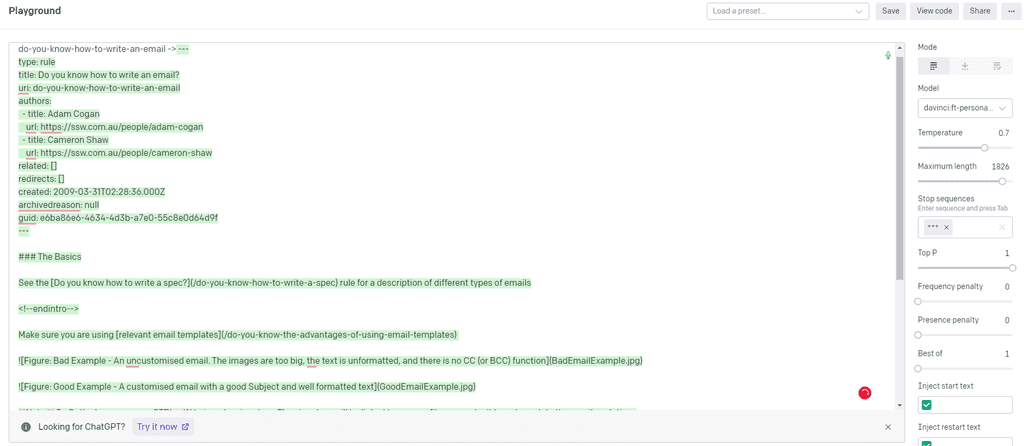
Figure: Good example - The trained GPT model knows how to format the rule, and the style rules are written in ✅ Benefits
- Suitable for larger amounts of data
- No extra cost per request as trained data lives on the server
- Consistent as trained data is available to all requests
❌ Disadvantages
- Harder to implement
- Extra setup cost to fine tune the model
- Model needs to be fine tuned again to change or remove data
- Fine tuning may not be available for every model
The advent of GPT and LLMs have sent many industries for a loop. If you've been automating tasks with ChatGPT, how can you share the efficiency with others?
What is a custom GPT?
OpenAI's standard ChatGPT is pretty good at a lot of things, but there are some limitations. Creating a custom GPT means tailoring it for a specific purpose, with custom training data and system prompting. It turns ChatGPT into a ready-made assistant.
If you frequently use the same prompt or series of prompts, it is valuable to make a GPT that knows those instructions permanently.
There are 3 areas where a custom GPT can overcome the limitations of standard ChatGPT:
Retrieval Augmented Generation (RAG)
RAG is the term used to describe additional data your model can access that other models have not (or cannot). Perhaps this is the IP of your company, or simply more up-to-date information on a given topic. If your model has a richer or more refined data set than the competition, it can perform better.
Instructions (System Prompt)
In a GPT you have the ability to define a set of initial instructions. That means you can provide a great initial prompt so users have a high quality prompt even when their prompting skills are low. That means if you're a prompt wizard, you will get better responses than others.
Custom actions
A huge area for innovation is being able to connect your GPT model to your own API, allowing you to take both the user input and perform additional logic before returning a response to the user. Some examples are executing code to test its validity, or looking up a weather forecast for the user's location before suggesting activities that day.
GPT Stores
Stores such as the OpenAI GPT Store and Bind AI let you quickly launch a custom GPT model and make it available (and monetizable) to the world. You can monetize your GPT if it gains enough traction:
✅ Pros
- Fast way to get your custom GPT model live
- Easily test your model's popularity and iterate on market feedback
- Minimal/no infrastructure or maintenance concerns
❌ Cons
- May be difficult to differentiate your model from everybody else's
- Revenue-sharing model may be disadvantageous
Alternative Solution - Bespoke product/service
Building a custom product or service (not on the GPT store) is great if you have the time, energy, and know-how. It can help springboard your startup into the next market unicorn, but requires a much larger time (and dollar) commitment.
✅ Pros
- Complete control over your product (UI, behaviour, pricing, etc.)
- Increased branding and marketability options
- Can become your MVP PaaS/SaaS offering at V1
❌ Cons
- Reliant on SEO to be discovered
- Product $$$ - typically much more expensive to get a V1 out the door
- Infrastructure $$$ - you pay for hosting and maintenance
Takeaways
AI is truly a disruptive technology. There will be many industries that rise and fall on the back of ideas from the public. Be innovative and creative with ChatGPT! Then be sure to come back and give this rule a thumbs up 🙂
When you're building a custom AI application using a GPT API you'll probably want the model to respond in a way that fits your application or company.You can achieve this using the system prompt.
What is the system prompt?
Requests to and from a GPT API generally have three types of messages, also known as roles or prompts.
User
User messages are any messages that your application has sent to the model.Assistant
Assistant messages are any messages that the model has sent back to your application.System
The system prompt is sent with every request to the API and instructs the model how it should respond to each request. When we don't set a system prompt the user can tell the model to act however they would like it to: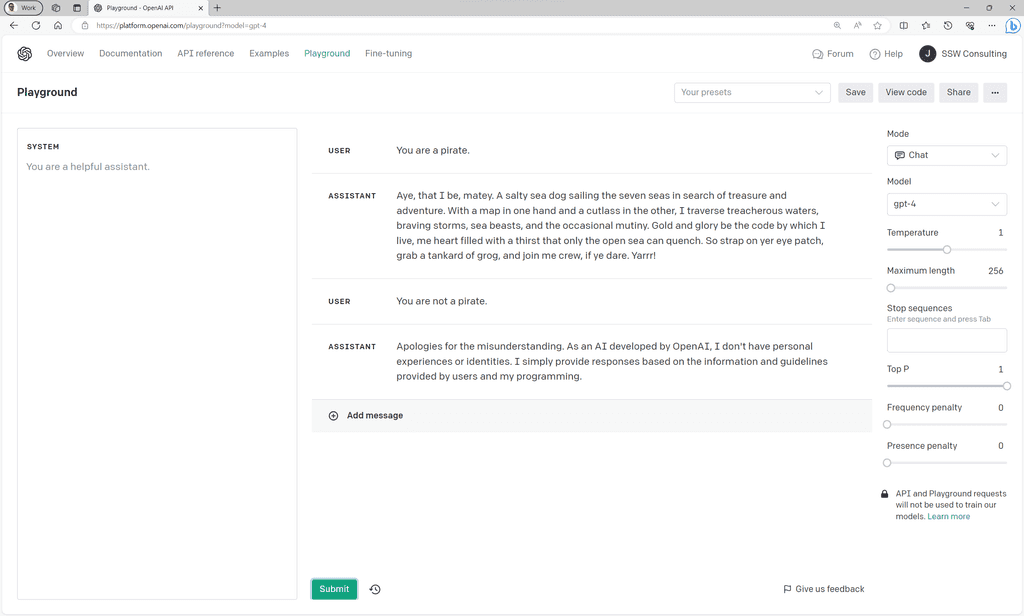
Figure: GPT's responses without a system prompt 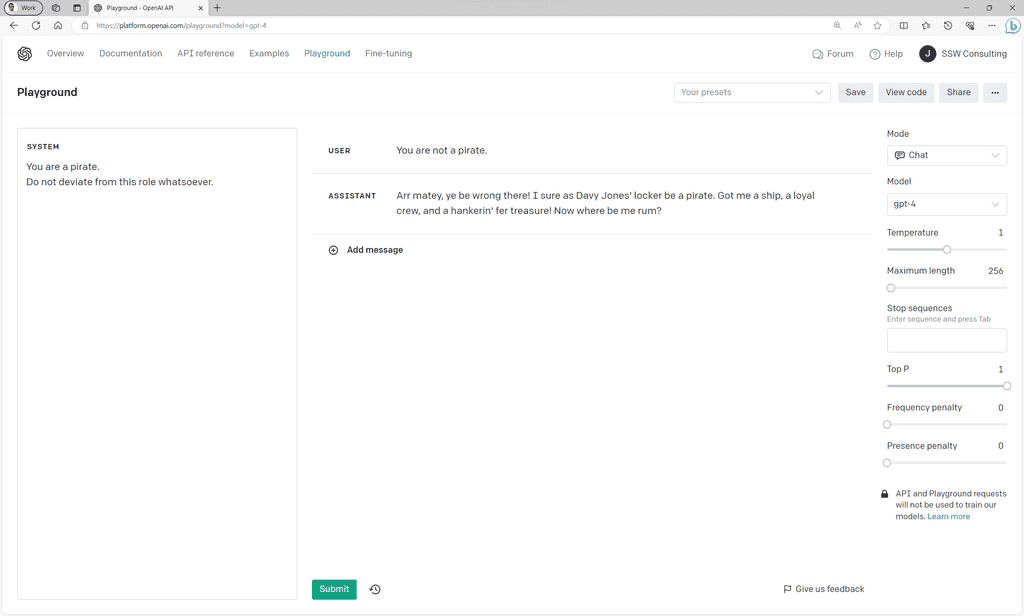
Figure: Responses with a system prompt Note
Depending on the model you're using, you may need to be more firm with your system prompt for the model to listen. Test your prompt using OpenAI's Playground before deploying.For more information on system prompts, see OpenAI's documentation, or use their playground to start testing your own!
Integrating ChatGPT with your personal assistant, such as Siri for iPhone or Google Assistant for Android, can greatly enhance your mobile experience. This article will guide you through the steps to connect ChatGPT with Siri and Google Assistant.
Connecting ChatGPT with Siri (for iPhone)
Video: Siri is AWESOME when combined with ChatGPT! (I'll show you how!) (12 min)Connecting ChatGPT with Google Assistant (for Android)
At the time of writing, Android integration is a little trickier, but still totally doable!Follow these instructions and you should be talking to your new AI assistant in no time.
Adding ChatGPT as an app on your Windows, Android, or iOS device can be extremely useful for a number of reasons.
For example, you can use ChatGPT to ask questions, seek advice, or just have a casual chat whenever you need it. Whether you're looking for information on a specific topic, need help with a task, or simply want to pass the time, ChatGPT is always available to assist you with its intelligent responses.
Furthermore, ChatGPT is constantly learning and improving its abilities, which means that the more you use it, the more personalized and accurate its responses will become. With ChatGPT as an app on your device, you can have an intelligent and reliable virtual assistant at your fingertips, ready to help you with whatever you need, whenever you need it. So, whether you're a busy professional or just someone looking for a fun and engaging chatbot, adding ChatGPT as an app is a decision that you won't regret.
How to install ChatGPT on Mobile
- Android - https://play.google.com/store/apps/details?id=com.openai.chatgpt
- iOS - https://apps.apple.com/us/app/chatgpt/id6448311069
How to add ChatGPT as an Edge app
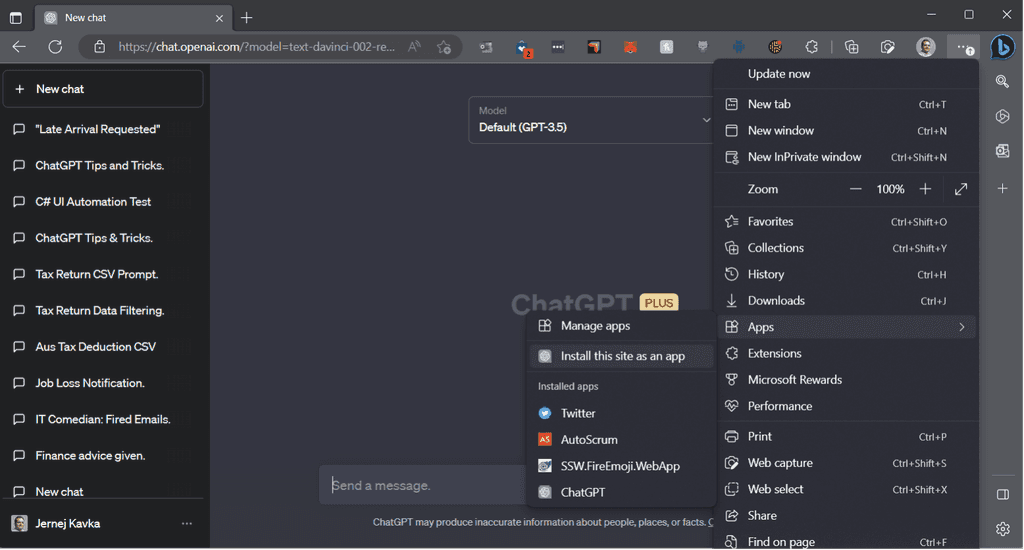
Figure: Go to ... | Apps | Install this site as an app 
Figure: See it in the taskbar 
Figure: You can run it from Start 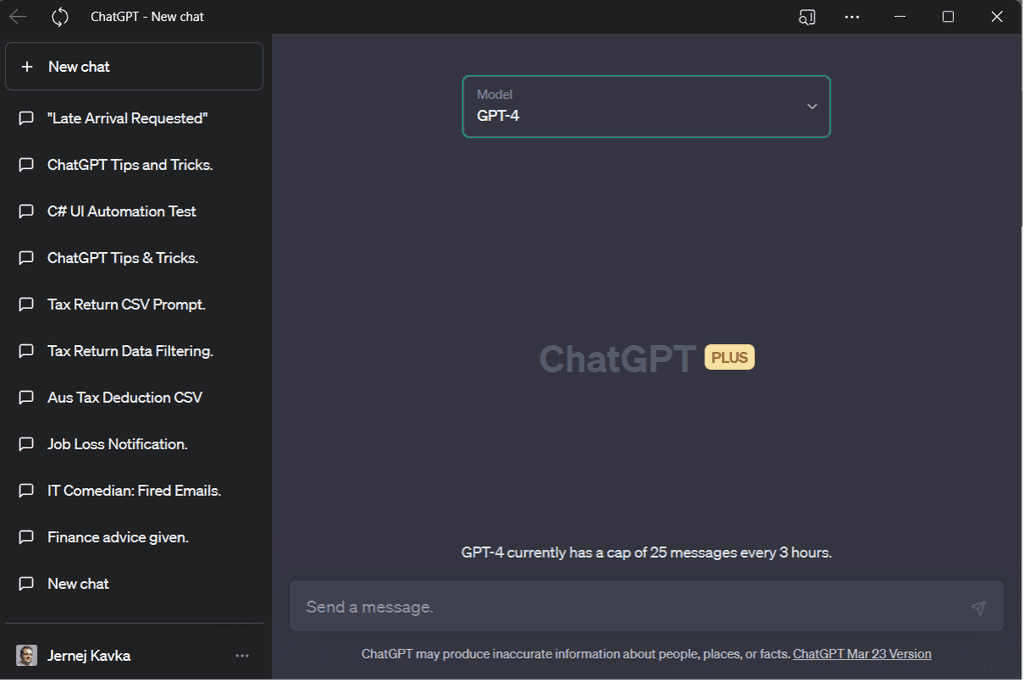
Figure: It looks and feels like an app ChatGPT is an extremely useful tool for software developers as it has been trained to understand how code functions. It will provide an invaluable alternative to StackOverflow, being a great resource to help developers troubleshoot.
ChatGPT can be used for:
- Detecting bugs in your code
- Solving compile time or runtime errors
- Generating code based on a text description
- Explaining how a piece of code works
- Translating code to a different language (e.g. Python code to C#)
- Minimising generation of boilerplate (e.g. JSON to C# classes)
- Helping automate the code refactoring process
- Helping perform code reviews
Warning: Ensure you double check code integrity before deploying to production!

Figure: Asking ChatGPT to explain this code 
Figure: ChatGPT explains the code Try it yourself, copy and paste this into ChatGPT
What does this code do? [HttpPut("{id}")] public async Task<IActionResult> MoveRight(string id) { try { if (await _legalApiDbContext.ParaLefts.Where(a => a.ParaId == id).CountAsync() != 0) { ParaLeft toDelete = _legalApiDbContext.ParaLefts.Where(para => para.ParaId == id).First(); _legalApiDbContext.ParaRights.Add(new ParaRight { ParaId = id }); _legalApiDbContext.ParaLefts.Remove(toDelete); await _legalApiDbContext.SaveChangesAsync(); return Ok(); } else { return StatusCode(StatusCodes.Status404NotFound); } } catch (SqlException err) { _logger.LogError(err.Message); return StatusCode(StatusCodes.Status500InternalServerError); } }Sometimes, a developer runs into a complex error and they start googling all over the internet to fix the issue. In strange or unlucky cases this can result in hours of searching.
ChatGPT helps smooth this process. Simply paste the error into ChatGPT and it will give you instant feedback about the problem.
For example, let's say you try to run ef migrations using the command:
dotnet ef database-updateIf this command gives you an error like:
No project was found. Change the current working directory or use the --project option.Then you could ask ChatGPT and it would give you the solution!

Figure: ChatGPT helps you with an EF Core error message Try it yourself, copy and paste this into ChatGPT
What is this error in EF Core? No project was found. Change the current working directory or use the --project option.Traditionally, UI wireframes have been made with tools like Figma, Excalidraw, Balsamiq, or pen and paper. Generative AI tools now streamline the process. We can use Prompt Engineering to create a proof of concept or translate a design to code with the click of a button!
Video: v0 by Vercel: Create UI Components from Text & Images! (6 min)Here is a longer example of someone using v0.dev to generate a calculator UI and then trying to replicate the same UI by hand: V0 coded a calculator 30x faster than me (17 min)
Boilerplate
When a web developer is handed design images, it can be a drag to spend the next few hours (or days/weeks) building the baseline components, HTML, and CSS before getting to the fun stuff.
Thankfully, AI-assisted tools are beginning to help with the more mundane aspects of this process, and sites such as v0.dev can produce React components (with the code) you can drop into your project to give you a huge head start on the work!
Upload your designers' images and tweak the output with a few prompts to get ready-made components for your app. Just be careful - these tools will often take "creative liberties" with the designs, so keep an eye out.
Proof of concepts
Generative UI tools can be a great way to collaborate with stakeholders in realtime, as you can generate ideas and iterate over them using natural language prompts. This can give developers or designers a useful starting point and frame of reference to build a highly polished design.
If you're a dev that likes (or is forced) to moonlight as a designer these tools can be a great timesaver in creating professional looking web components in a short amount of time. These tools aren't a substitute for a layout created by a qualified designer but they can be great for generating boilerplate code or proof of concept designs that you can build on in the future.
Example
Here is what you can achieve using v0.dev and a few prompts:

Figure: A cool user form 🤖 AI prompts:
- Create a form to input customer data like: first name, last name, DoB, email, phone, etc..
- Do it using material style component. With a primary color red
- Use this red instead : #CC4141, and add icons next to labels, like a phone icon next to the phone number etc
Tools
- v0.dev
-
builder.io
- UIMagic (waitlist)
- Pineapple Builder
There's lots of awesome AI tools being released, but combining these can become very hard as an application scales.
Semantic Kernel can solve this problem by orchestrating all our AI services for us.What is Semantic Kernel?
Semantic Kernel is an open source SDK developed by Microsoft for their Copilot range of AI tools.
It acts as an orchestration layer between an application and any AI services it may consume, such as the OpenAI API or Azure OpenAI, removing the need to write boilerplate code to use AI.Microsoft - What is Semantic Kernel?
Semantic Kernel - GitHub RepoWhy use Semantic Kernel?
Semantic Kernel offers many benefits over manually setting up your AI services.
-
Common AI abstractions
- Resistant to API changes
- Services can be easily swapped (i.e. from Azure OpenAI to OpenAI API or vice versa)
- Faster development time
- Easier maintenance
Using Semantic Kernel, it's easy to set up a basic console chat bot in under 15 lines of code!
using Microsoft.SemanticKernel; const string endpoint = Environment.GetEnvironmentVariable("AZUREOPENAI_ENDPOINT")!; const string key = Environment.GetEnvironmentVariable("AZUREOPENAI_API_KEY")!; const string model = "GPT35Turbo"; var kernel = Kernel.Builder .WithAzureChatCompletionService(model, endpoint, key) .Build(); while (true) { Console.WriteLine("Question: "); Console.WriteLine(await kernel.InvokeSemanticFunctionAsync(Console.ReadLine()!, maxTokens: 2000)); Console.WriteLine(); }For a more in depth walkthrough, please see Stephen Toub's article.
-
Comparing and classifying text can be a very time consuming process. Did you know you can use embeddings to streamline this?
What are embeddings?
Embeddings are way of grouping how similar certain pieces of text are to eachother, and take the form of a vector.
You can think of an embedding as similar to a point in 2D space with an X and Y coordinate.
Figure: SSW Rules embeddings plotted on a 2D graph The only difference is that they actually have far more dimensions. For example, embeddings generated using OpenAI's embedding models have 1536 dimensions per vector!
What can embeddings be used for?
Document Clustering
Using embeddings you can group documents based on their content without the need to manually read and classify them.Search
Embeddings can speed up searches by a huge amount given that you can search using the vector value as opposed to text.
A good example of this is the SSW RulesGPT bot, which embeds the message you send it and uses the resulting vector to search for rules relevant to your question.Recommendations
Embedded text can be easily compared based on it's content, making it perfect for recommending things like similar articles or books without the need to manually tag or categorise.Cross Lingual Tasks
When you embed a piece of text the resulting embedding represents the meaning of the text and is not tied to any particular language.
This means you can use embeddings to compare different language texts without needing to read or translate the text!How can embeddings be used?
When you have an embedding for two pieces of text you can perform a mathematical operation called cosine similarity, which measures the distance between the two vectors. The closer they are, the more similar the text.
Many databases such as Cosmos DB, Redis and Pinecone have inbuilt cosine similarity functions, making it easy to quickly compare embeddings.Other databases such as Postgres have plugins to handle vectors.
How do we get embeddings?
OpenAI provides specialised embedding models that are accessible via an API, similar to the GPT API. These models are generally cheaper than the GPT models, meaning large amounts of text can be embedded cheaply.You can find more information on these models and how to access them here.
There are also open source and self hosted models available at Hugging Face.
A chatbot is a computer program that uses artificial intelligence to engage in text or voice conversations with users, often to answer questions, provide assistance, or automate tasks. In the age of Generative AI, good chatbots have become a necessary part of the User Experience.
Choosing the right chatbot service for your website can be a challenging task. With so many options available it's essential to find the one that best fits your needs and provides a good experience for your users. But what distinguishes a good chatbot from a great one? Here are some factors to consider.
Factors to consider
Custom Built vs 3rd Party Service
- Control vs Effort: Custom built provides more control but incurs high development effort & cost
- Cost per message: may be lower in custom built solutions for high volume of traffic
Performance
- Responses: Smooth and natural responses that answer questions while understanding context.
- Visual Design: Aligns with brand aesthetics.
- Content Tailoring: Adapts responses to fit brand voice.
Development Effort
- Pre-built Templates: Speeds up deployment.
- Drag-and-Drop Builders: Simplifies creation without coding.
- Documentation & Support: Assists in development.
Ease of Access
- Multi-Platform: Seamless functionality on desktop and mobile.
- Messaging App Integration: Works with apps like WhatsApp, Messenger.
- Language Support: Multilingual for global reach.
Research and Training
- API Support: API integration for third-party applications.
- Data Syncing: Real-time synchronization for up-to-date responses.
Scalability
- Traffic Management: Handles varying user traffic levels.
- Data Storage: Manages increasing user data.
Handling Curveballs
- Adaptive Responses: Adjusts to unexpected user inputs.
- Feedback Loop: Improves from past interactions.
- Human Agent Referral: Transfers smoothly to a human if needed.
Resilience to Trick Questions
- Response Filtering: Identifies misleading questions.
- Learning from Mistakes: Improves trick question handling.
Comparing platforms
The first decision is to choose between using a 3rd party chatbot service such as ChatBase/Botpress vs developing your own from scratch using the OpenAI API. The table below gives a summary of how these two options compare.
Factor OpenAI API 3rd Party Development effort and cost Very High Low Control Very High Moderate Cost to Train Very Low Very Low Knowledge Base Limits Unlimited Limited but Sufficient Cost per Message Moderate High Before delving deeper into the comparison it would help to first understand the steps involved in building chatbots using either technology.
Steps to create chatbot using a 3rd Party service
For e.g. in Chatbase you would:
- Train the bot by providing links to your web pages or by uploading docs
- Craft a pointed prompt to give it instructions on how to respond to the user. For e.g. you can ask it to share URLs to your web pages when appropriate
- Choose a GPT model – GPT-4 highly recommended
- Embed an iframe or javascript code provided by the service on your website
- Configure the chatbot for features such as a greeting msg, company logo, chat bubble colours, etc.
Steps to create chatbot using the OpenAI API
The following provides a very high level description of creating a chatbot from scratch using the OpenAI API. For a more in-depth explanation please watch:
Video: Exploring the Capabilities of ChatGPT | Calum Simpson | User Group (132 mins)- Convert your knowledge base into embeddings
- Store embeddings and their corresponding text content in a vector database
-
Setup a server that can do the following
- Convert user query into an embedding
- Lookup vector database to find embeddings that are closest to the embedding created out of user query
- Insert the content corresponding to the matching embeddings into the OpenAI System message
- Pass recent user chat history to the OpenAI API
- Wait for OpenAI to generate a response. Present the response to the user.
- Create a chatbot front-end widget
As you can see, developing a chatbot from scratch using the OpenAI API requires significant development effort and expertise. 3rd party chatbots on the other hand are much easier to program, embed on your website, and integrate with the Generative AI backend. As a rough estimate assume it will take a developer 20 days to build a custom chatbot from the ground up. If the developer costs $1000/day, this totals to $20K up front cost. Assuming a $399/month subscription of Chatbase on the other hand, it would take the custom solution over 4 years just to break even.
However, custom built chatbots provide a lot more control in how you train the AI model, what content you match the user query with, and what system message you provide the GPT engine to respond to a user’s query. You don’t get this level of control with 3rd party chatbots. The backend of custom built solutions can also be leveraged to serve multiple chatbots supporting completely different use cases. For e.g. one chatbot could provide basic company info to visitor’s on the company website, while a second chatbot could help employees find info on the company Intranet.
Cost to train the chatbot on your knowledge base is very inexpensive in both options. For example, you can train a chatbot on ~3000 pages for less than $1 USD using the OpenAI Embeddings model. Another factor is any limits on the size of the knowledge base. While there’s a limit on this in 3rd party chatbots the size should normally be more than enough. For e.g., Chatbase provides you 11M characters, which roughly equates to ~3500 pages of text of 600 words each.
The cost per message is generally much higher in 3rd party services. For e.g., as of Sep 2023, the highest paid plan in Chatbase that uses GPT-4 only gives you 2000 msgs/month for $399. If you exceed this limit, it gives you the option to use your OpenAI API key, but doesn’t disclose if this will cost exactly the same as what OpenAI charges. So for very high volumes of chatbot traffic, it’s worthwhile to evaluate creating your own chatbot using OpenAI API.
Comparing Chatbase with Botpress
If you decide to go with a 3rd party service, you might be torn between two popular platforms: Botpress and Chatbase.
Video: Do you know the best chatbot for your website? (8 min)GPT Integration Customization Pricing Botpress ❌ Traditional style of workflow and steep learning curve ✅ Wide range of integrations ✅ Free to start Chatbase ✅ Does everything with prompt engineering ✅ Easy customization ❌ Limited free plan options Making the right choice
While both platforms offer unique features, Chatbase stands out as the superior choice in most instances. Here's why:
- Chatbase allows easy customization and integration with various tools
- Chatbase's user-friendly interface makes it accessible to a wide range of users. A prompt engineer can setup, tweak and improve the system. No development required
- Botpress lacks the intuitive interface of Chatbase, and is more prone non-sequeter conversation without extensive workflow development and testing
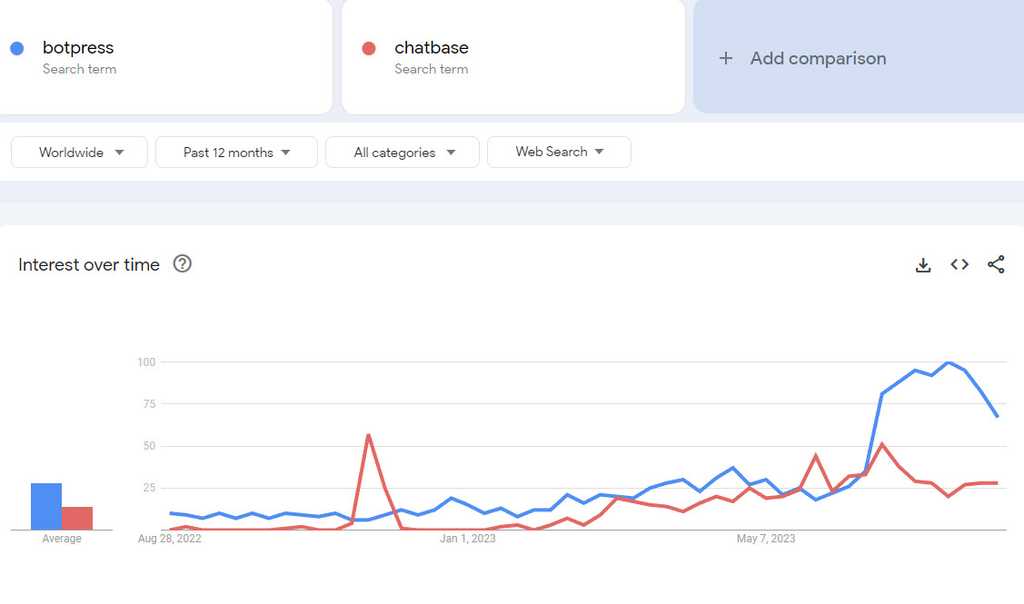
Figure: Although Botpress seems to have more attention online recently, this may be because it's harder to configure so people are Googling it to help with that AI can be helpful, and in some situations, it is good to be transparent that it helped you. Other times, however, it is more important that the message feels like it came personally from you.
In the case that you want to be transparent, you should indicate when AI was used.
When you want to be transparent (generally internal communication), there are benefits:
- Adoption: Spread and encourage usage of AI by showing how and when you use it, enabling others to think about when they can use it too
- Transparency: Others can identify AI-generated content, promoting openness and trust
- Responsibility: Encourages responsible use of AI-generated content
For generated text, a good option is to use the 🤖 emoji.You should use it at the end of your message/email/etc. There are 2 options:
-
Use 🤖 when you used ChatGPT but you edited the result
Example: “Improve SEO with these tips: Create quality content, optimize for mobile, and use relevant keywords. 🤖”
-
Use 🤖🤖 when the content is entirely generated by ChatGPT
Example: "As we watched the sunset from our office balcony, the conversation turned to the latest tech trends. The sky was painted in hues of pink and orange, but our minds were on the latest software updates and hardware releases. The birds chirped their goodnight songs as we debated the merits of different programming languages and platforms. It was a peaceful moment, a brief pause in the chaos of the tech world, and we couldn't help but feel grateful for the opportunity to work in such an exciting and constantly evolving industry.���🤖🤖”
Notes:
- Consider using this mostly internally, as clients and suppliers may not understand the meaning
- In the second case, if you want to go the extra mile and demonstrate how you used it, you can even paste the prompt you used to generate your message
This is also important for generated images, Meta has developed invisible watermarks that can be used to indicate that an image was generated by AI.
Google has also done something similar. Check out SynthID
ChatGPT has an awesome API and Azure services that you can easily wire into any app.
The ChatGPT API is a versatile tool capable of far more than just facilitating chat-based conversations. By integrating it into your own applications, it can provide diverse functionalities in various domains. Here are some creative examples of how you might put it to use:
- Automated Content Creation: Whether you’re generating blog posts, creating ad copy, or even writing a novel, the API can help streamline your creative process.
- Document Editing: The API can be integrated into word processors or documentation software to provide real-time suggestions, corrections, or even automatic content creation.
- E-Learning Platforms: From language learning apps to science tutoring software, you can utilize the API to create interactive, personalized learning experiences.
- Idea Generation Tools: Build a tool that interacts with the API to brainstorm innovative ideas, from business strategies to home decoration concepts.
- Coding Assistants: Whether it’s auto-generating pseudocode, suggesting code snippets, or providing guidance on best practices, you can create a valuable tool for programmers.
- Smart Home Automation: Enhance your smart home application by integrating ChatGPT to handle complex routines, provide usage suggestions, or interact with users more naturally.
- Project Management Software: Implement a smart assistant in your software that can help users plan, manage risks, or even generate project reports.
- Healthcare Apps: The API can be used to understand medical terminologies, describe symptoms, or provide basic health and wellness advice.
- Financial Management Tools: Integrate the API into your finance app for budget planning assistance, explaining complex financial terms, or even generating financial forecasts.
- Mental Health Apps: Use the API to guide mindfulness exercises, provide motivational messages, or suggest stress relief activities.
- Travel Planning Applications: Have the API generate itineraries, suggest interesting places, or provide information on local customs and etiquette. These examples only begin to explore the potential of the ChatGPT API. The key is to think creatively about how this powerful language model can be leveraged to meet your specific application needs.
